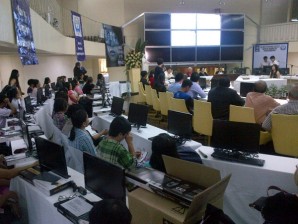MANILA, Philippines—The Parish Pastoral Council for Responsible Voting (PPCRV) has found “no clear evidence” of a suspicious pattern in the results of the May 13 senatorial elections, saying that voting percentages were typical voting “tendencies” observed in any electoral exercise.
Debunking suggestions of an almost fixed 60-30-10 proportion of votes in favor of the administration coalition, the Church-based watchdog’s information technology (IT) experts found that voting percentages were in ranges instead of a consistent singular pattern.
“At the precinct level, there is adequate variation in the percentages of votes grouped by party. The shapes of the curves shown are what would typically arise in almost any election,” said PPCRV trustee John Paul Vergara, a computer science professor at the Ateneo de Manila University.
PPCRV IT director Rommel Bernardo, who led the study, found that the proportion of votes for the political groups “cluster around identifiable percentage ranges” instead of fixed points.
“If one were to consider the values observed for each political group at each geographic subdivision, there is no clear evidence that the data for each group consistently clusters tightly around a single number as one moves from the national level to the regional and provincial levels,” said Bernardo.
His conclusions in the study were posted on the PPCRV site on Thursday.
The Automated Election System (AES) Watch, an election watchdog, recently said that the results seemed to show a consistent pattern with 60 percent of the votes going for Team PNoy, 30 percent for the United Nationalist Alliance, and 10 percent for other candidates.
Despite what its statement implied, AES said it was not directly suggesting fraud.
Vergara explained, however, that the AES analysis showing a clustering of election results was expected to have “less variation, particularly since the voter numbers represented in these groups were in the hundreds of thousands or in the millions.”
PPCRV’s own study, which it initiated after AES bared its 60-30-10 theory on May 22, analyzed election results at the national, regional and provincial levels using electronic data it had received from the Commission on Elections (Comelec) Transparency Server.
The data analyzed included results from 59,677 clustered precincts, 77 percent of the total number of precincts nationwide that were able to transmit results to the Manila server. The remaining 23 percent had yet to transmit results, the PPCRV said.
PPCRV trustee William Yu, also an Ateneo computer science professor, said the per-level analysis showed that proportions varied on the national, regional and provincial levels.
“This simply shows a hard coded 60-30-10 isn’t present but it does show voting tendencies for this election,” he said.
The PPCRV conducted a parallel count of electronically transmitted data during the election and continues to manually encode election returns (printouts) from various provinces for its independent audit. The audit will compare the electronically transmitted and manually encoded results to see if there are discrepancies.
PPCRV media director Ana de Villa Singson said they would like to know why 23 percent of precincts failed to transmit data to the transparency server, limiting the PPCRV’s electronic data to 77 percent of the total precincts nationwide.
The Comelec earlier explained that the weak reception of the telecommunications networks may have affected the electronic transmission from the precinct count optical scan machines. The PPCRV is still hoping for a sufficient explanation, however.
“It is critical to focus on truly important issues. Still of paramount importance is an appreciation and understanding of the almost 23 percent of precincts that did not transmit to the transparency server. We need to understand the reasons for not transmitting,” said Singson.
The PPCRV will continue with its manual encoding until June 7 and is expected to issue a report of its own audit afterward.
